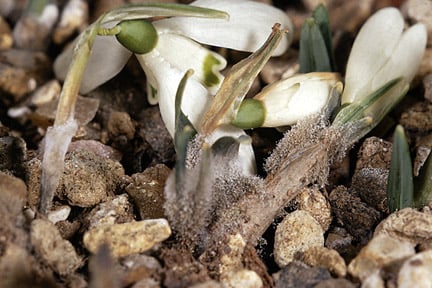
Quick facts
Common name - Snowdrop grey mould
Scientific name - Botrytis galanthina
Plants affected - Galanthus spp. (snowdrops)
Main symptoms - Fuzzy grey mould, collapsed leaves and flowers
Caused by - Fungus
Timing - From mid-winter
What is snowdrop grey mould?
Botrytis galanthina is a fungus, closely related to the common grey mould fungus Botrytis cinerea. Check for symptoms from mid-winter when leaves emerge.
This fungus only attacks Galanthus spp. and is most severe on G. nivalis. It is worse in mild winters.
Symptoms
You may see the following symptoms:
- On leaves and flowers: Fuzzy grey mould
- On : Infection can spread to the bulbs, which rot. Small, black, seed-like structures (sclerotia) can be found on the surface of the bulbs and in the lower portions of the shoots, and occasionally in the leaf tissues or roots
Control
Non-chemical control
- Sclerotia can contaminate the soil, so if the disease is detected remove affected promptly and destroy them
- Do not plant snowdrops where the disease has occurred previously
- If buying new bulbs or propagating from existing ones, inspect them carefully and avoid any with visible sclerotia
- Galanthus nivalis Scharlockii Group and G. plicatus show resistance
Chemical control
There are no chemicals available to gardeners to control the disease.
Biology
Botrytis galanthina is closely related to the grey mould pathogen Botrytis cinerea. B. cinerea has a very wide host range, but B. galanthina is one of a number of species which attack specific plants, in this case only Galanthus spp.
Botrytis galanthina forms small, black, seed-like structures (sclerotia) in the tissues it kills. The sclerotia germinate as the new shoots develop, releasing spores which infect and kill the shoots. The fungus produces a fuzzy grey mould which releases airborne spores and these spread infections to new plants. The fungus can spread back down to the bulb and forms new sclerotia on the infected scales.



